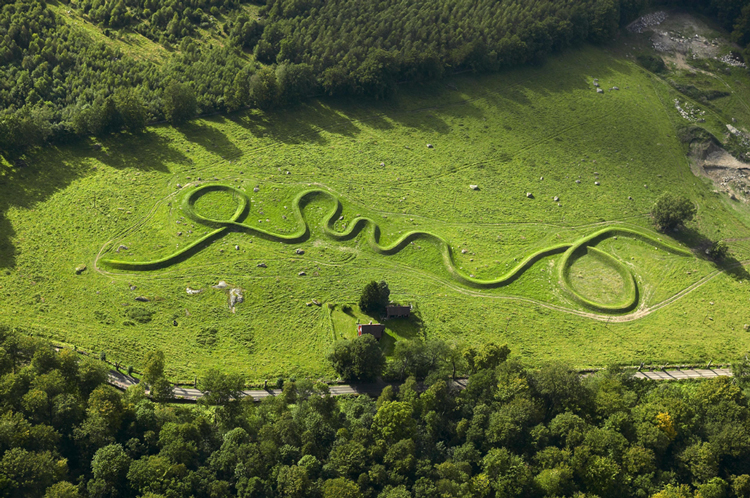“The artist comes first,” says Marika Wachtmeister, referring to the core philosophy of Wanås, one of the most remarkable contemporary art venues in the world, which she founded in 1987. Located in southern Sweden, Wanås is unlike anywhere else, offering a glorious combination of contemporary art and nature with a little history thrown in. In addition to contemporary art, the bucolic estate boasts a magnificent castle—originally built as a medieval fortification—beautiful parkland and some of the most interesting agrarian structures I have ever seen: enormous barns with brick, stone and stucco facades, now converted into exhibition spaces. With over 1,000 cows in residence, keeping company in a pasture with Maya Lin’s Eleven Minute Line (2004), Wanås is also one of the largest organic dairy farms in Northern Europe.
Wachtmeister spent her high school years in New York City, where she was captivated by the vibrant art scene. Seeing Niki de Saint-Phalle and Jean Tinguely’s The Fantastic Paradise (1968), an outdoor installation in Central Park’s Sheep Meadow, was a seminal experience, planting a seed from which Wanås has clearly grown. A dyed-in-the-wool feminist, Wachtmeister did not pursue art when she returned to Sweden for university, choosing instead a profession (law) that would ensure independence.
Wachtmeister’s transition from law to art occurred after her family moved to sleepy Knislinge in the 1980s to help run her husband’s family estate. Though Wanås has been a professionally administered foundation since 1996, it started quite casually. The first year, Wachtmeister, inspired by two outdoor sculpture shows she had recently seen, invited 25 artists to exhibit works on the estate, and it went from there.
As word spread within the insular art world about the nurturing and supportive environment of Wanås, it began to attract more renowned artists. Fast forward 25 years and you have the highly acclaimed arts organization Wanås has become. Aside from the enormous satisfaction of creating it, Wachtmeister also discovered a pursuit that combined her love of art and New York, which she visited regularly searching for artists.
Early on, Wachtmeister made the decision to focus on site-specific works that centered on the remarkable setting that is Wanås. “Wanås made artists brave,” she explains, “inspiring them to try things they might not have done before.” The original work was, for the most part, playful, ephemeral. Now it’s more serious and enduring. Of the 53 pieces currently in the collection, only Bernard Kirschenbaum’s minimalist Cable Arc survives from the first year.
Wachtmeister has recently passed the baton to Co-Directors Elisabeth Millqvist and Mattias Givell, who come from Stockholm’s distinguished contemporary art space, Magazine 3. Wanås will continue its current format of presenting two new artists each year (plus a “Revisit” artist—a returning artist from the collection), but it’s redirecting its focus to include more Third World voices. Millqvist is eager to see how artists from nonwestern cultures and far-flung parts of the world interact with Wanås. She’s also committed to Wanås’ vital educational outreach programs.
I was enchanted by Wanås. Most of the installations are situated within the fairytale forest, which not only means the aesthetic integrity of the estate is preserved, but you get to experience a wonderful scavenger hunt of discovery as you wander through the woods in search of artwork that is spread over 1.5 square miles (It takes about six hours). Visiting as the season was winding down, I had the park to myself and it was magical and, at times, quite mysterious.
There are many art stars in the collection, including Yoko Ono, Robert Wilson, Ann Hamilton, Janet Cardiff, Jenny Holzer, Marina Abramovic and Antony Gormley. Louise Bourgeois’ “Maman” spent a season there—and though she coveted it, Wachtmeister decided the $8 million price tag was better spent in other ways. A number of artists were new to me: Marianne Lindberg de Geer, Malin Holmberg, Esther Shalev-Gerz, Jacob Dahlgren—my favorites.
What is most compelling about Wanås is the way art and nature and art in nature are treated. Wanås manages to honor both the artwork and the natural beauty of its location. It strives for and achieves an intimate experience between viewer and artwork and also provides a most memorable one.
By following her passion and embracing the new and the challenging, Wachtmeister has done something amazing with what might have been an onerous family legacy. Nowadays, Wanås is more vibrant and relevant than ever with a reach that extends across international borders, contributing in numerous ways to the advancement of culture.



